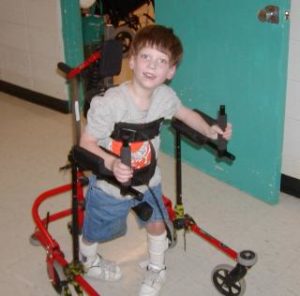Diplegic Cerebral Palsy
Diplegic cerebral palsy is one of the most-common types of CP, and manifests itself in weakness (diparesis) or complete impairment (diplegia) of two symmetrically-opposed parts of the body — usually both legs.
Diplegia usually affects the lower limbs, and children with diplegic CP often have an abnormal scissor gait. Individuals with diplegia may lock their pelvis and hips while walking, and their ankles may turn inwards. In addition, their thighs and knees may touch or cross while walking.
Cerebral palsy is an umbrella term used to describe a number of motor neuron abnormalities caused by damage to the brain. While the brain damage that causes CP cannot be reversed, the vast majority of children born with diplegic cerebral palsy can go on to live rich, rewarding lives as long as they get the support and treatment they need.
Signs & Symptoms
Many children with diplegic CP also suffer from spasticity. In children with spastic diplegic cerebral palsy, the muscles can be so stiff that walking without assistance can prove impossible. Unaided, children with spastic CP tend to make stiff, jerky movements, and can have trouble with grasping or grip strength. Due to this stiff musculature, there is a risk of tendons stiffening and remaining in one position for extended periods of time, raising the risk of conditions such as blood clots and bone spurs.

Diplegic Cerebral Palsy
Here are some of the early symptoms of diplegic cerebral palsy in very young children:
- A hunched posture while sitting.
- The child’s feet are turned inward due to stiff muscles.
- The child is not be able to stand on their own two feet by the age of 3.
- Sitting in a “W” formation instead of the cross-legged conventional sitting style.
- The child prefers to use their arms/hands to move around (as opposed to their legs) while crawling.
Here are some of the most common causes of diplegic cerebral palsy:
- Prenatal infection which moves from the mother to the baby, bypassing the protective environment of the womb.
- Hypoxia, which basically means low oxygen levels in a baby’s blood. This can happen if the baby is left in the birth canal for too long, or if the child’s blood and oxygen supply to the brain is cut off due to asphyxiation or strangulation.
- Fetal brain trauma, which could be caused by birthing aids such as forceps and vacuum extraction.
- Bleeding in sensitive areas of the brain caused by an avoidable event during pregnancy, labor, or shortly after birth.
- Kernicterus and hyperbilirubinemia
Diplegic cerebral palsy isn’t always immediately apparent; it often takes time for the symptoms to present themselves. It’s likely that you may start to see signs a few months to a year after your child’s birth. Thus, it is important to see a specialist in order for a proper diagnosis to be made.
Treatment Options
Since diplegic cerebral palsy affects the muscles, it can be a painful ordeal for your child to have to put up with on a daily basis. Physical therapy as well as regular massage therapy can help relax these muscles so your child’s pain can be alleviated.
Activities such as horseback riding are usually highly encouraged due to their role in helping improve muscle tone, and elastic therapeutic taping (which helps muscles relearn how to contract and relax at the right time) can also help.
In addition, certain medications (such as or Botox) are used on a regular basis to minimize muscle stiffness. Surgery may be an option for this kind of CP, but it is important that a diagnosis be made as soon as possible to mitigate complications and begin treatment early.
